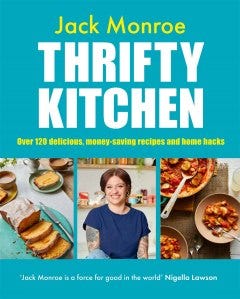
What’s the USP? As the title (which bears a striking similarity to the BBC TV show Thrifty Cooking in the Doctor’s kitchen with Dr. Rupy Aujla on which Monroe appeared as guest) suggests, this is a ‘bumper’ collection of recipes intended to be wallet friendly without sacrificing flavour. The book also includes Monroe’s ‘Home Hacks’ – money saving tips and tricks to help you budget in the kitchen.
Who is the author? That’s a very good question and one that not even Monroe herself seems to know the answer to. That probably sounds a bit cryptic if you aren’t familiar with the name Jack Monroe but will make perfect sense to anyone who has followed her career over the last decade or so.
If you are new to Monroe, before continuing to read this review, I would recommend reading Tattle’s Jack Monroe Wiki (a word of caution, Tattle is very definitely a site for grown ups. While the Wiki is entirely factual, if you stray to the forums be prepared for some very strong opinions and even stronger language).
For a more potted version of events in Monroe’s public life and career, see the Awfully Molly blog which is partly based on Tattle’s work. Author Katie Roche’s Jack Monroe: An Investigation is also well worth reading. At the time of writing this review, a further investigation into Monroe’s fund raising activities was due to be posted on justpikachoo.com. This recently published Guardian profile is also well worth a read.
If you don’t want to do the reading (although I strongly recommend you do, it is quite the ride) Jack Monroe is the author of seven cookbooks, a food writer, journalist, blogger and activist campaigning on poverty related-issues and in particular hunger relief. She appears occasionally on TV, mostly as a poverty pundit but has demonstrated recipes on This Morning and Daily Kitchen Live among other programmes.
There has been some public debate about her effectiveness as a campaigner as well as her abilities as a food writer and TV presenter. Nevertheless, she has half a million followers on social media and makes what is estimated to be a healthy income from her Patreon account which, at the time of writing had somewhere between 588 and 647 subscribers each paying between £1 and £44 a month. Until recently, subscribers had received little of the content and rewards promised by Monroe. Currently, the account has just one post which is in fact an apology from Monroe for not supplying said content and rewards.
Although she does attract a fiercely loyal following (referred to by Monroe as her ‘flying monkeys’ who vociferously defend her against any negative comment on social media) and has celebrity supporters including restaurant critic Jay Rayner, food writer Tom Parker Bowles and TV cook Nigella Lawson, she is a controversial figure to say the least. Before parting with your hard earned money for this book, it is worth investigating Monroe’s background in order to assess if you are comfortable supporting her financially.
I personally have no wish to do so but was forced to spend my own cash as repeated requests for a review copy were ignored by the publisher (never a good sign when a publisher appears not to want reviews ahead of the publication date). As I don’t want it in my house longer than it takes to review, I plan to donate my copy to my local Amnesty International book shop (I changed my plans and got a refund instead. My thinking was that, even if Amnesty made a few quid from the sale, some poor charitable soul would end up with a duff book so it seemed best for everyone if I just got my money back) .
Is it good bedtime reading? `This is the first book on this blog that comes with a health and safety warning. Prior to it’s release, Thrifty Kitchen trended on social media due to a downloadable preview of the book available via Apple books and other online stores going viral for the contents of an introductory section titled ‘If You Don’t Have This, Try This’. Among some truly bizarre ‘home hacks’ (which bear more than a passing resemblance to to Viz magazines famous top tips) was the advice to use a mallet and ‘a small sharp knife’ as a can opener.
Such was the resulting furore that publishers Pan MacMillan briefly withdrew the ebook of Thrifty Kitchen from pre-sale to make some hasty edits and then published a safety statement saying that ‘Bluebird has amended text in the e-book edition, and will do the same for future reprints, removing or amending some of the content that has been flagged, and adding enhanced safety information at the back of the book.” In a reply to Twitter account @AwfullyMolly (a blogger highly critical of Monroe), food bank charity Trussell Trust, which was due to receive up to a thousand donated copies of Thrifty Kitchen, said, ‘The books that will be donated to our food banks will contain an addendum that addresses any health and safety concerns and we will not be distributing any books via our food banks in the current form.’
Many of the other ‘home hacks’ have been criticised online for being batshit crazy including using a square of cotton, four carabinas and an s-hook in place of a colander or hoarding the water from a condenser tumble dryer in recycled drinks bottles to use for mopping the floor with. There is a very strong sense of a teenager being forced to do their homework by a stern parent about these parts of the book. It may be that they were included at the request of the publisher and Monroe struggled to come up with enough useful and credible hints and tips, was bored and taking the piss to see what she could get away with. And she got away with an awful lot as it turns out.
What has been included either doesn’t work (my wife tested the firelighter made with an empty loo roll tube stuffed with tumble dryer fluff – no, really – and it was literally a damp squib although some people apparently swear by the method), doesn’t really address a real problem (using a flannel to dry yourself after a shower in order to save space in the washing machine – what?!) or saves virtually no money (using old t-shirts as cleaning cloths. I’d rather keep wearing the t-shirt around the house – I have some that are nearly 20 years old – and buy a new cloth. Hasn’t Monroe ever heard of the pound shop?). Also, I have never managed to make icing sugar from granulated sugar by blending it (although apparently food writer Nancy Birtwhistle can).
The less said about ‘The Quarterhack’ the better. OK, I suppose I ought to say something. Basically, this translates from Monroe-speak as checking your kitchen cupboards, fridge and freezer for what food items before you do the weekly big shop so you don’t waste money. That advice is almost so sensible and obvious that it’s not worth writing down, except we’ve probably all done a spur of the moment shop or just couldn’t be bothered to check what we already had and have ended up with five jars of pesto or three bottles of soy sauce. OK, just me then.
Monroe takes things a step further however and suggests dividing a sheet of A4 into four columns (hence ‘quarterhack’. Christ.) and heading them Protein, Carbohydrate, Fruit and Veg and Snacks. You then note down every single item of food you have in your house under the appropriate column and then you…I don’t know, I gave up reading and ordered a Dominoes at that point. All you need to know is that it’s an unnecessarily complicated and unworkable methodology for what should be a very simple thing.
Monroe also claims the ‘quarterhack’ is how she manages to feed two adults (including herself) and her son for £20 a week. This is probably the most pernicious claim in the book. It’s one that Monroe makes regularly and which has seen her compared to Conservative politicians who claim that those living on the poverty line only need to learn how to budget better and how to cook in order to feed themselves. If Monroe does actually only spend £20 a week on food, it’s because she has spent a larger amount in the past in order to stock up her cupboards, fridge and three freezers (yes, she has said on social media that she has three freezers). It’s a ludicrous claim, allowing only 95p per person per day for food. Unless you are serving up plain lentils three times a day, there is just no way to meet that figure. Tellingly, Monroe offers no example meal plan setting out exactly how to feed three people a day for £20 a week, probably because she can’t.
So the short answer to ‘is it good bedtime reading’ is no because you are much better off not reading it. Let’s move on to the recipes. Bound to be on safer ground there, this is Monroe’s seventh cookbook after all.
How annoyingly vague are the recipes? Fucking hell. If I see ‘generous fistful’, ‘a few pinches’ ‘plenty of’, unspecified amounts of oil ‘for greasing’ or ‘for frying’ (it doesn’t matter what it’s for, how much? A teaspoon, a tablespoon? It’s not hard is it?), unspecified amounts of ingredients for garnishing (how much ‘optional bread and blue cheese for the Roasted Roots Soup? FFS, just work it out and write it down!!) unspecified varieties of mushrooms and potatoes (yes they really do matter, especially if you are going to roast the potatoes and you want them to ‘fluff up at the edges’, Charlotte or Ratte for example are not going to work. Just say King Edwards. How could that be difficult? How could it be difficult for an editor not to notice? Did the book even have an editor, at least one that gave a shit?) unspecified ‘soft fresh herbs’ (what if I don’t know the difference between soft and hard herbs. I mean, rosemary is quite soft isn’t it? Is that what you mean? Can’t you just bloody say what you mean?) I will bloody well scream.
And why does every clove of garlic in MonroeWorld have to be fat? Do I have to throw away the skinny ones? That’s not thrifty is it? I was going to count the number of times the world ‘generous’ appears in the book but I’m not an actual nut job. It’s a lot though, and it’s very annoying and very vague (edit – a kind reader of this blog with a Kindle version of the book has confirmed that Monroe uses the word 89 times, which is a generous amount and one way of meeting the publisher’s required word count).
Among all this vagueness, Monroe goes to the effort of specifying ‘cold fresh water’ in her recipe for Lemon and Rosemary Roast Potatoes (annoyingly, there is no rosemary in the recipe, just dried mixed herbs which don’t contain rosemary. Why isn’t it called Lemon and Herb Roast Potatoes? Hello, editor, are you there?). Maybe this is to ensure you don’t use the supply from your collection of 2l bottles of tumble drier water that is no doubt now cluttering up your under-sink cupboard.
Will I have trouble finding ingredients? No. Monroe is famously a loyal Asda shopper so you will have no problem buying any of the ingredients in the book.
What’s the faff factor? Probably not high enough to be honest. Some of the recipes are almost comically short. Lemon sardines on toast are just that, tinned sardines (which are already cooked) fried in their own oil and lemon juice (can you fry something in lemon juice?) served on a thick slice of toast. That’s it. You can buy sardines in oil and lemon by the way. Instant cheesy mash is a mix of instant mashed potato flakes, dried skimmed milk powder and dried hard cheese which you put in a jar and then throw away because no one in their right minds wants to eat a mix of potato flakes, milk powder and rancid dried cheese. Chicken and cannellini soup is a tin of beans that is simmered for 20 minutes for some reason (the beans are out of a tin, they’re already cooked) in water, a stock cube, lemon (why?) and ‘plenty of black pepper’. No fat clove of garlic for some reason, that would have been highly appropriate and added some character and flavour to the soup. But yum I guess. Chicken porridge is oats cooked with milk and a stock cube. Oh stop it, you’re spoiling us.
As with many of the dishes in the book (see below), you will find similar recipes online for chicken porridge. They are slightly more complex in that they actually have herbs and spices and other ingredients that make them worthwhile cooking. It’s a common theme in Thrifty Kitchen; Monroe adapts a recipe found easily online but in the process of making it ‘her own’ she often removes ingredients that make the thing worth the effort of cooking.
She admits in the book that this is the basis of her working method, saying ‘This is how I work when trying something new; I compare and contrast three or four recipes, picking out fundamentals and common denominators, then weave in what I think will be the best bits from each, to my own tastes and intuition. Most of the time it works a charm.’ There is nothing intrinsically wrong with this of course, many recipe writers work in a similar fashion I’m sure, after all, Felicity Cloake based an entire Guardian column and several ‘Perfect’ books on it. The key objective however is to come up with something better than already exists not just something different so you don’t get sued.
How often will I cook from the book? There may be 120 recipes but the same ingredients seem to pop up again and again. Ask yourself how much you like eating lentils, crab and fish paste, tinned tomatoes, lemon in just about bloody everything and endless cans of various beans. One of the utterly astonishing things about the book is that, although Monroe uses cannellini, borlotti, chickpeas and butter beans etc throughout the book, they are always tinned and she never recommends the much cheaper dried versions, surely the staple of any truly thrifty kitchen?
I found little in the book to inspire me into the kitchen. I love a roast chicken and am always on the look out for new ways to cook one. I often use Simon Hopkinson’s famous version from Roast Chicken and Other Stories and there is an excellent recipe in The Bull and Last Cookbook that includes a wonderful red wine gravy. I would also highly recommend spatchcocking a chicken and cooking it in an air fryer if you have a model that’s big enough. A 1.5kg bird will cook to bronzed perfection in about 40 minutes, a more thrifty method than using your oven. Surprisingly, Monroe never mentions air fryers or slow cookers in the book, two thrifty pieces of equipment that would be as much use as the bullet blender she recommends to make the white sauce mentioned below.
So what is Monroe’s signature roast chicken move you ask? Well, you take your chicken and put it in a lightly oiled roasting tin (there is no other fat used in the cooking process. Yeah, I love a dry chicken too), season it with salt and pepper and cook it for an hour or ‘according to package instructions’. That’s right, you’ve paid £19.99 (or if you are thrifty, £9.99 via Amazon, who you can send it back to for a refund once you’ve realised your terrible mistake) for a book to tell you to follow the instructions on the ‘package’ your chicken came in. Bad luck if you bought it from your butcher. She serves it with ‘coronation slaw’. I never want sultanas with my chicken so, fuck that. The introduction to the recipe is bizarre, banging on about geese and her Greek Aunty Helen and not mentioning chicken, or what to do with it once. It’s like no one checked to see if it made any sense or that it might be the introduction to another recipe entirely.
I don’t really want to eat Butter Bean, Veg and Stuffing Stew for my tea, but even less I don’t want to cook a recipe that advises me to toss chopped onion and garlic cloves sliced in half (why do I want great lumps of garlic in my stew?) to a dry cold pan, then pour over oil and seasoning and then turn the heat on. I think this is meant to be some sort of energy saving ‘hack’ (although she doesn’t actually say anything in the book about it) but how much energy do save by not heating you pan for thirty seconds so your ingredients cook properly? And if Monroe is so worried about saving fuel, why does she then say to cook very finely diced carrots and already cooked tinned butter beans for 40 minutes. And then cook for a further 10 minutes after adding thinly sliced courgettes and the stuffing crumbs. Imagine the claggy mess you’ll end up with.
In an introduction by Nigella Lawson, not written for the book but taken from a BBC 4 Radio programme, she calls Monroe a ‘kitchen savant’ with ‘a deep and instinctive understanding of the alchemy of cooking’. Far be it from me to contradict one of our finest food writers, but the butter bean stew recipe and many others in the book read like they were written by someone with little understanding of cooking techniques and not much interest in eating. That appears to be born out by the three recipes I tested from the book.
Instant white sauce
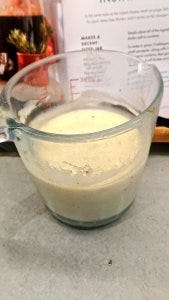
A quick and simple recipe that produced a sauce of sorts. It’s not much of a surprise when you discover that there are dozens of similar recipes online like this one. The only problem was that it tasted rank. Well, what do you expect from microwaved milk, flour, oil and mixed dried herbs (one of Monroe’s favourite ingredients sadly. Who uses mixed dried herbs anymore)?
Monster Bums
Not a spelling mistake, just Jack’s little joke. Spinach and parsley bread rolls that her son squished together before baking so they looked like an arse. Ha. Ha, and indeed, Ha. I’d have more of a sense of humour if the recipe didn’t make me look like an arse too. For a cookbook aimed at non-expert bakers, including a recipe for bread that is around 80 per cent hydrated (i.e. has a lot of water in it. Not unusual in modern baking but a tricky technique to master) makes little sense. The use of plain flour rather than strong bread flour is also perplexing and probably a significant factor in why the recipe didn’t work as it should have done.
I followed the instructions as best as I could. However, the dough was so wet and sticky, made even more slack by the addition of defrosted frozen spinach (the recipe made no mention of draining the veg so I didn’t) which pushed the hydration level up even further, that it was impossible to knead on the worktop as per the recipe. With high-hydration doughs I would usually use the stretch and fold method made famous by US baker Chad Robertson and now much copied, but unfortunately not by Monroe. I ended up manipulating the dough as best I could with a dough scraper, an implement I would imagine few of Monroe’s intended audience would have and not something she recommends in the book’s Basic Kitchen Equipment section. I persevered for the prescribed 10 minutes but the result was less than ‘springy’.
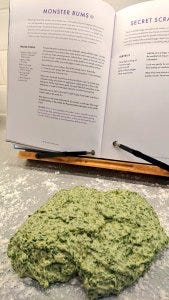
Once ‘kneaded’ the dough needs to rise for three hours. Three feckin’ hours! Instead of doubling in size as per the recipe, the dough just laid there like a food writer sleeping through the Guardian knocking on their door at 12.30pm to get them to a photo shoot for a Saturday supplement cover story that shows them in an extremely bad light, even though they themselves think it’s good PR for them.
The lack of rise may have been due to the way the dough was mixed. Monroe says to blend the spinach and parsley with warm water and then add to the flour and yeast. By the time I’d finished blending, the water had lost most if not all its heat. I often use cold water when making a dough but I then prove the dough overnight in the fridge. So I could have made this work but testing my baking skills and knowledge was not the point here, it was to see if the recipes in the book actually worked.
Using my dough scraper again I managed to form the dough into, well, small bits of dough and left them to prove again for another hour during which time fuck all happened.
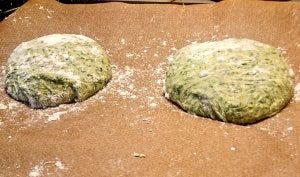
I then baked the rolls, if you could call them that for an astonishing 50 minutes at 140C. They needed a further 10 minutes to cook through. Why the long bake at a low temperature I have no idea and Monroe doesn’t explain. The oven needed to pre-heat too. It was the least thrifty bread recipe I think I’ve ever cooked. The result was at least edible if not particularly nice, the baked spinach and parsley gave the bread a faintly metallic taste and the long slow bake didn’t seem to have made any difference to the finished result. They could have been baked at 220C for 10-15 minutes and come out of the oven the same.
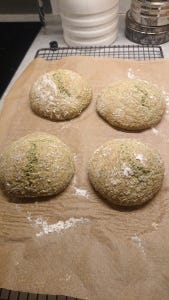
From start to finish, the process took close to six hours. As I had planned to spend the day in the kitchen that wasn’t a huge problem as I could get on with things while the dough was resting, but it’s a ludicrous amount of time only to end up with a bog-standard result that a more traditional method would have achieved in half the time. Although its not exactly like for like, compare this one hour pizza recipe from the brilliant YouTube chef Brian Lagerstrom. It’s been properly developed and tested and I can vouch that it works a treat and is delicious. It’s a useful recipe to have when you are stuck for ideas for a weeknight meal, which I’m not sure I would say about any of the recipes in Thrifty Kitchen.
Marmite Crumpets
These didn’t work. I mean, look at them. That’s after 50 minutes of cooking time. Apart from the addition of Marmite ( a nice idea by the way) the recipe ingredients and measurements are virtually identical to any you’ll find online or say, Delia Smith’s version (I like Gary Rhodes’s recipe from new British Classics which works a treat) so the mix should work.
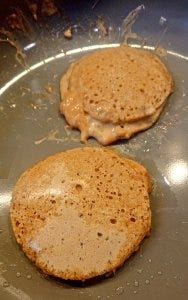
The first problem arose from the amount of mix Monroe says to use. Three tablespoons in a standard poaching ring just isn’t enough so you end up with something closer to a pancake than a crumpet. Secondly, the instructions state to use the smallest ring on the hob at the lowest setting. I happen to have an induction hob (hardly that rare these days) so the lowest setting is really low. Even though I pre-heated the pan at a higher setting as instructed, the crumpets, which should have taken around 10 minutes (that’s the minimum time according to Monroe, but she gives no maximum) just never cooked through. I cooked a second batch using more mix and a higher heat but they still refused to set properly and tasted unpleasant. Everything went in the bin, including the leftover batter which there shouldn’t have been any of. I halved the recipe which should have made four crumpets but the mix would easily have made eight three tablespoon crumpets. Did anyone check?
I intended to test more Thrifty Kitchen recipes, but it was so dispiriting, spending the morning in the kitchen and having very little to show for the time, effort and money spent on ingredients and fuel. Both the crumpets and the white sauce went straight in the bin. The bread was one of the most exasperating and tricky doughs I have ever made, and I bake a great deal, but the result was at least edible.
Killer recipes: Well, you might find yourself a digit missing if you follow the tin opener ‘hack’ but nothing will actually kill you, probably. I am of course kidding. Regular readers of this blog will know that ‘killer recipes’ refers to the dishes that make the book irresistible and a must buy. That doesn’t apply in this case. Thrifty Kitchen remains eminently resistible.
Should I buy it? I’m honestly struggling to come up with a good reason what anyone would want to part with the best part of £20 to own this book. As discussed, its useless from a home hack point of view, the recipes are for the most part unappealing and badly written and there is very little truly thrifty about the book. Yes, there’s recipes for veg peelings and fish paste but who the fuck want’s to eat those? Where are useful budget-friendly meal planners and shopping lists? At Jamie Oliver’s website, that’s where. For free. They don’t even cost £19.99. Nada, zilch. And they are bloody great. So please, do yourself a favour and save your money.
120 reasons you don’t need to buy this book (a project that will never be completed)
I started out when I wrote this review with the intention of completely negating the need to buy Thrifty Kitchen by finding exactly similar or as close as possible recipes available free on the internet by another author. I decided to stop after two chapters as it was massively time consuming, I felt I’d made my point and I have TV boxed sets to binge watch, bitches. I have included my finding as I think it shows that often, the free alternatives are a more enticing proposition than Monroe’s versions.
It should be noted that there is no accusation of plagiarism, the purpose of this is to provide a resource for those that can’t or don’t want to afford to buy Monroe’s book. Recipes titles on the left are Monroe’s from the book and, unless otherwise indicated, the linked recipe has the exact same title, although ingredients and method differ to varying degrees. The recipes linked to here are not necessarily the earliest posted online, just the first I came across so I’m not claiming they are necessarily any more original than Monroe’s versions.
I am aware that some of the recipes published in the book and billed as ‘brand new’ on the back cover have already appeared, either on Monroe’s blog or as part of commercial tie-ins with companies such as Del Monte and Netflix (Refried Potatoes with Blue Cheese is available here and a similar but much nicer sounding version by US chef Paula Deen here. It should be noted that Paula Deen is a very controversial figure too so I’m not endorsing her in anyway, but that recipe does sound bloody good) but I haven’t listed these as I am only one man and this is enough work by itself and I’m pulling 100 hour weeks and DO YOU WANT ME TO STOP BREATHING!
Breads and Breakfast
Courgette and cheese soda bread – BBC Good Food
Prune and pumpkin seed toast/bread – The Brown Paper Bag
Oaty soda bread – Tesco Real Food
Get Up and Go Muffins – BBC Good Food
Banana peel pancakes – Petit chef and Cooking on a Bootstrap
French toast – BBC Good Food
Raspberry and lemon curd baked oats – double berry baked oatmeal with lemon curd from The Oatmeal Artist
Warm sunshine oats – Sunshine Breakfast Baked Oatmeal Recipe from chocolatecoveredkatie.com
Lemon and berry Dutch babies – Lemon Dutch Baby With Fresh Blueberries from Saporito Kitchen
Monster bums – Spinach burger buns from myhomemadekitchen.co.za
Secret scrambled eggs (with mayonnaise) – Tender and fluffy scrambled eggs recipe from Hellmann’s
Pear and bacon porridge – bacon porridge (no pear, sorry) from tastefullyvikkie.com
Homemade muesli – Homemade muesli with oats, dates & berries from BBC Good Food
Cinnamon crunch – Cinnamon-toasted oats from Eating Well
Pear and cinnamon buns – Spiced Pear Cinnamon Rolls from wanderingchickpea.com
Apple bircher – apple Bircher muesli from pinkladyapples.co.uk
Light bites
Radishes and other crunchy veg with a trio of dips – (this recipe has just too many possible variations to track down something exactly similar so this one will have to do – crudites platter from crunchyradish.com)
Marmite crumpets – I think we’re going to have to give Monroe this one. Here’s some Marmite bread instead from Great British Chefs.
Roasted roots soup (with chickpeas) – roasted root vegetable and chickpea soup by Elise Museles
Pangrattato al Pomodoro (a version of pappa al pomodoro but made with dried stuffing mix) – the stuffing mix is a Monroe special, the closest I could get is pappa al pomodoro soup by Jamie Oliver
Veg peel fritters – Zero Waste Veg Peel Fritters by bottomfeeder.blog
Cream of mushroom soup – Mushroom soup from BBC Good Food
Roasted courgette and red lentil soup -Mediterranean Red Lentil and Zucchini Soup by dimitrasdishes.com
Chicken and cannellini soup – Chicken & White Bean Soup from Eating Well
Carrot, coconut and chilli soup – Lightly spiced carrot soup from BBC Good Food
Chicken porridge with a poached egg – chicken oats porridge from cookpad.com
Radish, soft cheese and lentil salad –Lentil Salad with Marinated Radishes (and goat’s cheese) by callingtochitchat.com
Lemon sardines on toast – Spanish sardines on toast from BBC Good Food
Cuisine: International
Suitable for: Beginner and confident home cooks
Cookbook Review Rating: Not rated
Buy this book: (on your own head be it) Thrifty Kitchen by Jack Monroe
£19.99, Bluebird




